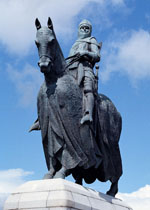House of Bruce (1306-1371)
|
Robert
the Bruce at the borestone, Bannockburn, Stirling. Charles d'Orville
Pilkington Jackson
(1887-1973). Bronze statue, 1964 |
NOT much is known about the early life of Scotland's hero king, but he would have been on the sidelines when the Scottish Crown was allocated to his cousin John Balliol in 1292. He was the eldest son of Robert de Brus, sixth Lord of Annandale, and Marjorie, Countess of Carrick, and his grandfather and father subsequently supported Edward I of England in the overthrow of King John, whom they regarded as a usurper.
In 1296, both the younger Robert and his father rendered homage to Edward I at Berwick-upon-Tweed. However, the former was ambivalent. He supported the Scottish revolt of the following year, relented in exchange for a pardon from Edward, he then changed his mind again with the Scottish victory at the Battle of Stirling Bridge in 1297. Edward I immediately plundered Bruce's lands in Annandale, and when Sir William Wallace, who had been appointed Guardian of Scotland, stood down following his defeat at Falkirk, Bruce and his cousin John Comyn were made Joint-Guardians of the Kingdom.
Both, however, had a serious claim to the throne of Scotland, and soon found themselves at odds with one another. In 1296, William Lamberton, Bishop of St Andrews stepped in to mediate between them, but Bruce resigned and Sir John de Soulis took over as sole-Guardian.
The conflict between Bruce and Comyn came to its climax in 1306 when the two men met at Greyfriars Church in Dumfries and Comyn was murdered. Bruce rode immediately to Scone where he was confirmed as King of Scots by the Scottish nobility. The English responded violently and Bruce went on the run, travelling through the Lowlands and to the Western Isles.
That same year, with only six hundred men, he defeated an English force ten times larger at Loudounhill. The news travelled fast and Edward I of England personally led an army north, but by then he was an old man and died on the march. His successor, Edward II of England was of a very different mould, preoccupied with his favourites at Court. In 1309, King Robert called a Parliament in St Andrews at which a peace treaty with England was proposed, but the skirmishing continued.
When Edward II finally invaded Scotland in 1314, Bruce was ready for him. At the Battle of Bannockburn the English army was soundly defeated and in the following year at Ayr, the succession of the Scottish throne was universally confirmed upon Robert Bruce, and, failing males of his body, his brother Edward and his heirs male, or failing them, Robert's daughter by his first marriage, Marjorie and her heirs. Shortly after this event, Marjorie married Walter Stewart, sixth Steward of Scotland.
King Robert had married first Isabella, daughter of the Earl of Mar, who died in 1296; secondly, Elizabeth de Burgh, daughter of the Earl of Ulster.
Although his situation was now secure, he had been excommunicated by the Pope. In 1320, the Scottish Clergy and barons petitioned Rome with the Declaration of Arbroath which declared the Nation's undying loyalty to its King. Although at first indifferent, Pope John XXII officially recognised King Robert I of Scotland in 1329, the year of his death. At the same time, the Treaty of Northampton between England and Scotland negated any claims that England still had over Scotland.


No comments:
Post a Comment